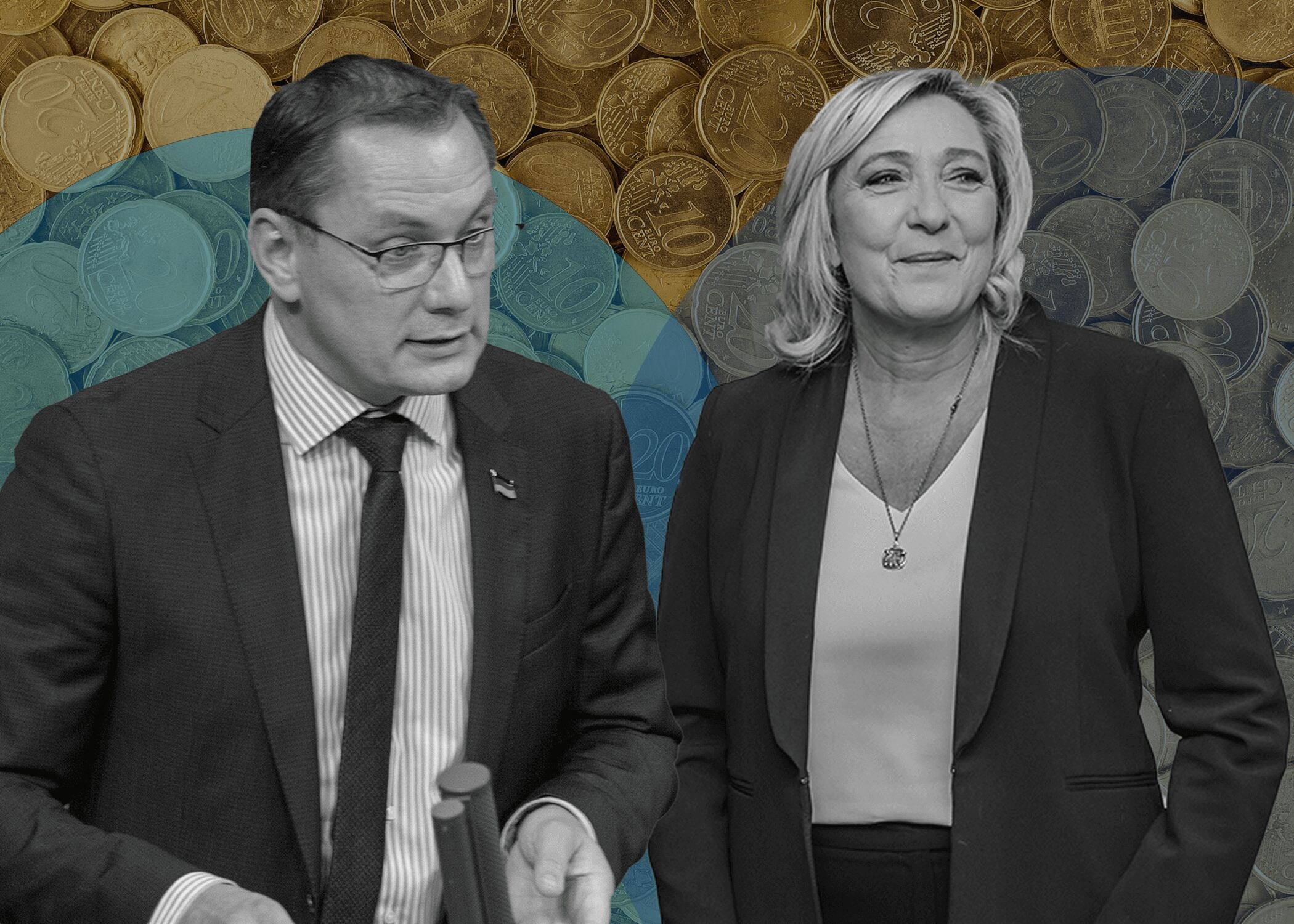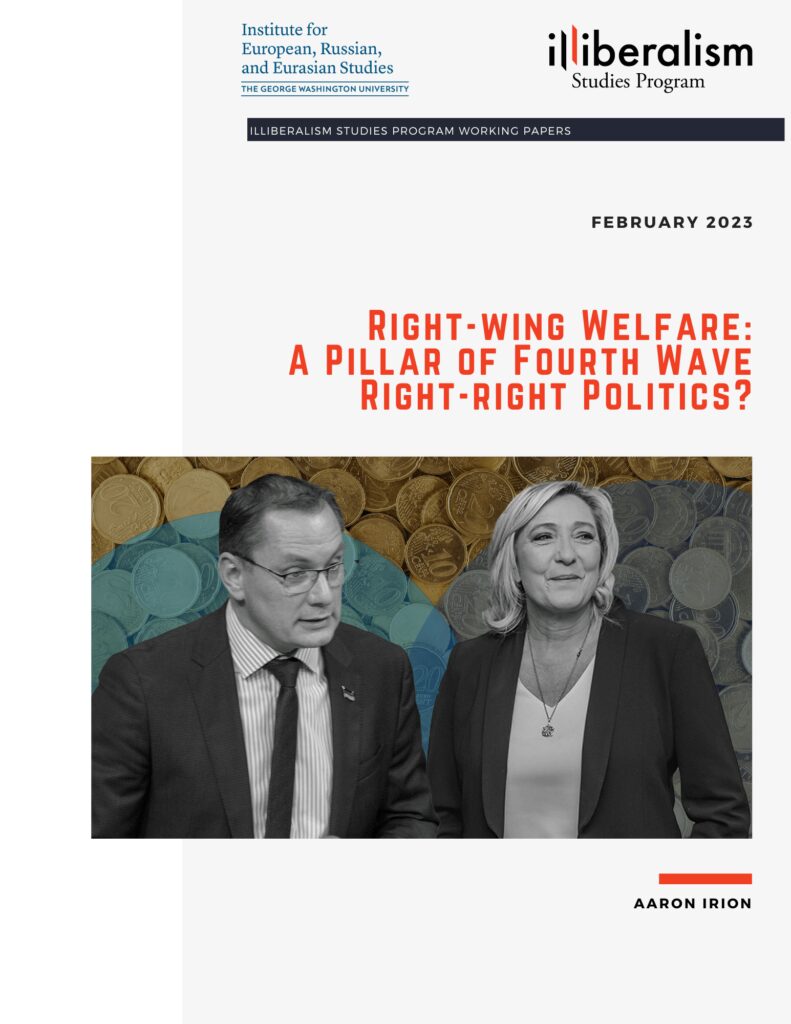
Right-wing Welfare: A Pillar of Fourth Wave Far-right Politics?
Aaron Irion
Illiberalism Studies Program Working Papers Student Papers Subseries no. 6 February 2023
Photo by John Chrobak made using “2020-10-30 Tino Chrupalla MdB AfD by OlafKosinsky 4961” by Olaf Kosinsky licensed under CC BY-SA 3.0-de
The contents of articles published are the sole responsibility of the author(s). The Institute for European, Russian, and Eurasian Studies, including its staff and faculty, is not responsible for any inaccurate or incorrect statement expressed in the published papers. Articles do not necessarily represent the views of the Institute for European, Russia, and Eurasian Studies or any members of its projects.
©IERES 2023
In advance of the 2022 French presidential election, major European news outfits ran headlines like “Marine Le Pen exploits cost of living fears as French run-off vote looms,”[1] “Macron’s opponent tries to woo the youth vote with giveaways aimed at easing the cost-of-living crisis,”[2] and “Voters in northern France wooed by Marine Le Pen’s cost of living policies.”[3] If one had not been following Marine Le Pen or the far-right Rassemblement National (RN) party she belongs to in recent years, these headlines may have been a shock. At once, they seem to undermine two quintessential pieces of wisdom about the European far right: that they do not prioritize economic issues, and if they do they prefer free-market, neoliberal policies. However, for those who know the transformation of the French far-right party, these headlines are far from surprising. Rather, they are indicative of a shift a long time in the making, and one that is affecting far-right parties across Europe, not only in France.
The purpose of this paper is to assess the relationship between some European far-right parties and redistributive politics and the welfare state today. I begin by defining the far right and reviewing the literature on far-right parties’ positioning vis-à-vis the welfare state and redistribution. I then offer a quantitative analysis of the French RN– known until 2018 as the Front National – and the German Alternative für Deutschland’s (AfD) support for the welfare state using data collected from their election manifestos. For reasons described in the methodology section, the data stretches back to the 1980s in the RN’s case but only to 2013 for the AfD. Then, I offer a qualitative analysis of the parties’ support for the welfare state.
Using both the quantitative and qualitative analysis, I find that the RN’s and the AfD’s support for welfare expansion has increased steadily and substantially over time. For the AfD, which was founded in 2013, this has meant increased support at every election between 2013 and 2021. In the RN’s case, the party began retreating from its neoliberal positioning in the late-1990s and early-2000s, but this process accelerated considerably after the 2008 financial crash. I also find that the literature’s traditional characterizations of the far right, and explanations of its stance on welfare issues, are severely lacking. I conclude by offering a brief and underdeveloped path forward, suggesting that perhaps it is time to speak of a “fourth wave” of far-right politics that includes a notion of the far right as a pro-welfare party family. This does not mean that every far-right party has become pro-welfare, merely that the trend towards pro-welfarism is potent and noticeable enough across time and space to contend with.
Terminology and Landscape
Like many political labels, “the far right” is a contested term. There are more and less robust conceptions, but most are filled with synonyms, modifiers, and adjectives, to the point that one easily becomes confused. To define it, it is important to first place it on a broad left-right continuum, which continues to have “major heuristic power.”[4] The left, generally, is characterized by its egalitarianism while the right is characterized by its anti-egalitarianism, “because [the latter’s] models of political and social order are rooted in the necessity and legitimacy of institutionalised inequality.”[5] In other words, for the political right “some are more equal—or, better, deserving—than others.”[6] This insight applies to the mainstream right as well as the far right. How then can the far right be differentiated from the mainstream right? The most important distinction is that the mainstream right endorses liberal constitutionalism and individual rights and freedoms, while the far right does not.[7]
Going beyond these broad strokes invites confusion. When one talks for instance about the extreme right, are they talking about something synonymous or distinct from the far right? Is right-wing extremism different than the extreme right? Is the radical right distinct from the far right or the extreme right? Defining these concepts and differentiating them from one another is the substance of extensive scholarly debates. Take just one of these terms – extreme right. As Cas Mudde explains in The Ideology of the Extreme Right, scholars typically define the term as “a political ideology that is constituted of a combination of several different features,” but “the number of features mentioned in the various definitions varies from one or two to more than ten.”[8] Some define the extreme right as simply the politics of racism, xenophobia, and nationalism, while others define it as ‘a collective term for anti-democratic dispositions and attempts, that are traditionally positioned at the extreme ‘right’ of the left-right spectrum,’ while others adopt a “shopping list” definition that includes (in the European context) “extreme nationalism, ethnocentrism, anti-communism, anti-parliamentarianism, anti-pluralism, militarism, law-and-order thinking, a demand for a strong political leader and/or executive, anti-Americanism and cultural pessimism.”[9]
Far right, radical right, populist radical right, and related concepts have similarly contested and sometimes tedious definitions. When it comes to differentiating between these terms, one place to start is with the general wisdom that “the extreme right operates in direct opposition to the democratic constitutional order, whereas the radical right bears more of a strained relationship with the tenets of liberal democracy, instead of democracy per se.”[10] In other words, while the extreme right contests politics with the intention of overturning democracy (or at least rolling it back), the radical right contests politics with the intention of rolling back liberalism and its core tenets of pluralism, social equality, etc. Still, defining these concepts and their relationship to others often amounts to little more than a “war of words.”[11] Despite some real differences, Mudde recounts twenty-two labels that, more or less, describe a singular phenomenon.[12]
Closing this Pandora’s box of definitions requires adopting something close to what Andrea L.P. Pirro calls the “umbrella concept” of the term “far right.” In the spirit of utility, Pirro sets aside the question of commitment to democracy, defining the far right as “all those ultranationalist collective actors sharing a common exclusionary and authoritarian worldview—predominantly determined on sociocultural criteria—yet varying allegiances to democracy.”[13] This is a purposefully broad definition, and includes within it the terms noted above like radical right, extreme right, etc. When I refer to far right parties, I am following Pirro in this regard and opt for this umbrella definition in part because the focus of this paper, the far right’s position on the welfare state and redistributive economics, is somewhat removed from the question of a party’s commitment to democracy, i.e., it is from the questions that differentiate various types of far-right actors. Following Pirro, the RN and the AfD are clearly recognizable as far-right parties.
Far-right Economics
Before I unpack the socioeconomic agenda(s) of the German and French far right specifically, it is important to place the socioeconomic agenda of far-right parties in a broader context. Afterall, as noted above, far-right parties are members of the right side of the political spectrum. What does this mean socioeconomically? Generally, contra the left side of the political spectrum – where political actors seek “as a central programmatic objective, to reduce social and economic inequalities,”[14] by increasing state expenditures, extending the coverage of social programs, emphasizing employment, and intervening in the labor market to expand workers’ benefits and rights”[15] – the right “do not place redistributive policies and social equality at the top of their programmatic agenda; instead, they prioritize economic stability and physical security.”[16]
This general typology partially explains why, for decades, scholars suggested that far-right parties are neoliberal. For some scholars, neoliberal economics are even “an essential feature of the parties’ ideology and success.”[17] In 1993, Betz partially attributed the success of the 1980s European far right to their embrace of “a radical neo-liberal program,” though he is clear in stating that the far right’s economic message played second fiddle to “authoritarian, xenophobic, nationalism.”[18] Three years later, Kitschelt and McGann suggested that the winning formula for far-right parties in Europe is a strong commitment to free markets paired with an ethnocentric cultural politics.[19] Ignazi explained the rise of far-right parties in Europe as a form of backlash to excessive state intervention in the economy.[20] Over time, the assertion that the far right is staunchly neoliberal began to fade as “many successful far right parties…adopted centrist or even leftist economic policies that promote[d] protectionism and the welfare state.”[21] This shift can be explained in part by the far right’s desire to “capture disenchanted industrial workers hurt by globalization, post-industrial society and the supply of cheaper immigrant labor.”[22]
However, this change was never hegemonic among Europe’s far-right parties. In fact, many far-right parties responded to the 2008 financial crisis – which intuitively would have been an opportunity to embrace social protection – by staking out an “anti-welfare” position that sought to reduce the welfare state for the “undeserving” by enacting policies that disproportionately aided the rich.[23] Other parties undertook a strategy of position blurring, i.e., they “emphasize their stance on some issue dimensions, while strategically evading positioning on others in order to mask the distance between themselves and their voters.”[24] In this case, far right parties blur their positions on economic issues in order to prioritize their positions on immigration, European integration, and the like. However, recent research suggests that the far right’s positions on the welfare state are, in some ways, “not so blurry after all.”[25] More precisely, far-right parties still blur their position on how generous the welfare state should be but are quite clear about what the welfare state should do; the far right prioritize consumption policies, e.g., healthcare and old age pensions, over social investments, like “childcare, tertiary education and active labour market measures.”[26]
Along these lines, my analysis looks to identify the positioning of far-right parties vis-à-vis the welfare state across time and space. The temporal element has explanatory power because it hints at the “macrostructural” factors that give rise to the far-right parties, e.g., the traditional wisdom as to why the far right found success in the 1980s and 1990s centers post-industrialization.[27] The spatial component is important because we know that “ideas and practices diffuse from successful [far right] parties to embryonic ones in other countries.”[28] They do so through the diffusion of “potent master frames,” e.g., the success of third wave far-right parties is attributed to the diffusion of a master frame that combines “ethnonationalism based on ‘cultural racism’ (the so-called ‘ethno-pluralist’ doctrine) and a populist (but not antidemocratic) anti-political establishment rhetoric.”[29] To test whether these theories continue to have explanatory power, I use the case studies of the RN in France and the AfD in Germany. While temporal analysis is much more robust in the case of the RN than in the case of AfD because the latter was founded only in 2013, both provide insights into the new strategies of some parties belonging to the European far right, and the new conditions that may be influencing their rise.
Methodology
In the section below, the party data comes from the Manifesto Research on Political Representation (MARPOR) corpus. I isolated two “indicators,” i.e., variables, from the data. The first is “welfare expansion,” labeled per504 in the MARPOR dataset, and the second is “welfare limitation,” labeled per505 in the MARPOR dataset. MARPOR scrubs party manifestos for so-called “quasi-sentences” and scores are based on the number of quasi-sentences, related to certain indicators, that are found within a party’s election manifesto. As they put it, “a value of 4.5 in a column named per501 indicates that 4.5% of the sentences in the party’s manifesto…were assigned the code 501 by an expert coder.”[30] In other words, a higher score on an indicator like per504 suggests greater support for expanding the welfare state, whereas a higher score on per505 suggests greater support for rolling back the welfare state. Horn et al. have empirically shown that MARPOR indicators “do measure what they are supposed to measure: emphasis on equality and welfare state expansion.”[31] Moreover, “if we assume that items 503 and 504 do not behave radically differently in other countries, they can be used as valid indicators of parties’ positions on the welfare state issue.”[32] Given their empirical soundness, I isolated per504 and per505 for the RN and the AfD. I also present the average per504 and per505 scores for all parties in both countries and compare the results. In doing so, the far right’s position on the welfare state can be compared not only across countries, but to an internal baseline.
Results
In the party’s early years, the results suggest that the RN blurred its position on the welfare state and economics by completely deprioritizing those issues. From 1986 to 1997, the party’s manifestos dedicated zero space to promoting welfare expansion. This is in stark contrast to France’s other parties that dedicated between five and seven percent of their manifestos on average to welfare expansion during the same time. In every election between 1997 and 2012, the RN increased the manifesto space it dedicated to welfare expansion but still ran on a platform that was far less generous than the average French party. That changed after 2012 when the party finally converged with the average and moved left on welfare expansion. (Figure 1).
Figure 1
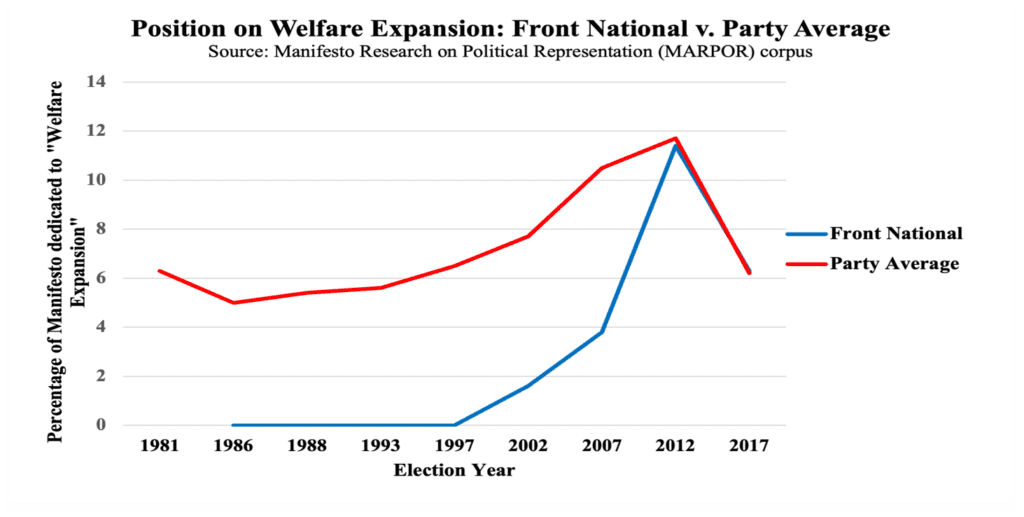
To the extent that the party did talk about welfare in its pre-1997 manifestos, it was strictly limited to a discussion about limiting welfare, not expanding it. Whereas the party ran far behind the national average in promoting welfare expansion, it dedicated nearly double the manifesto space of its counterparts to welfare limitation between 1986 and 2012. It was only in the 2017 election that the RN dedicated less manifesto space to welfare limitation than the average French party, and they did so by stripping the manifesto of any mention of welfare limitation at all, dedicating zero percent of their manifesto to the issue (Figure 2).
Figure 2
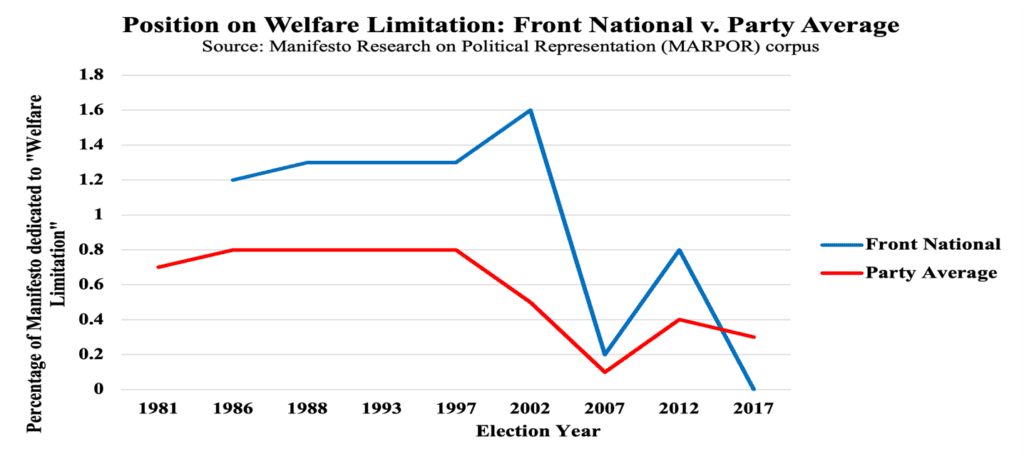
The German case both rhymes with and varies from the French. Though the timetable is significantly shorter, as the AfDwas founded only in 2013, what we see may be indicative of a trend, though we should proceed with more caution in this case than in the case of the RN, where far more data is available. Like the pre-2012 RNin France, the AfD runs behind the average German party on welfare expansion but has increasingly committed more manifesto space to the issue. Unlike the French case, this increased attention to welfare expansion has not led to a convergence with the average, as the average German party has also increased its dedication to welfare expansion since 2013. Thus, the AfD is becoming more generous in its welfare commitments, but not disproportionately so (Figure 3).
Figure 3
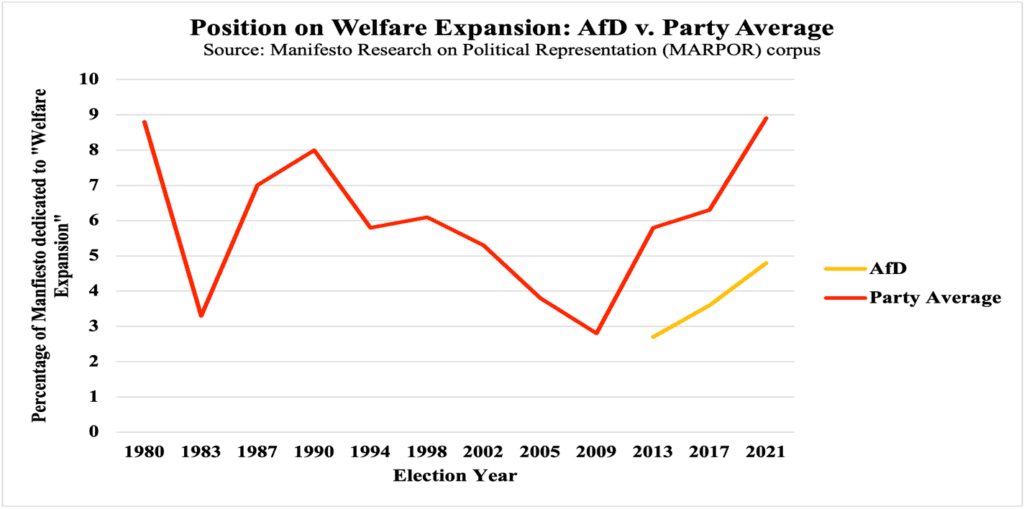
On welfare limitation, the AfDhas trended in the inverse direction of the RN. While for years the RN ran on limiting welfare, before completely axing the issue from its manifesto in 2017, the AfD did not campaign on limiting welfare in its first two election campaigns in 2013 and 2017. Then, in 2021, it suddenly adopted a stance on welfare limitation that was slightly more aggressive than the German average (Figure 4).
Figure 4
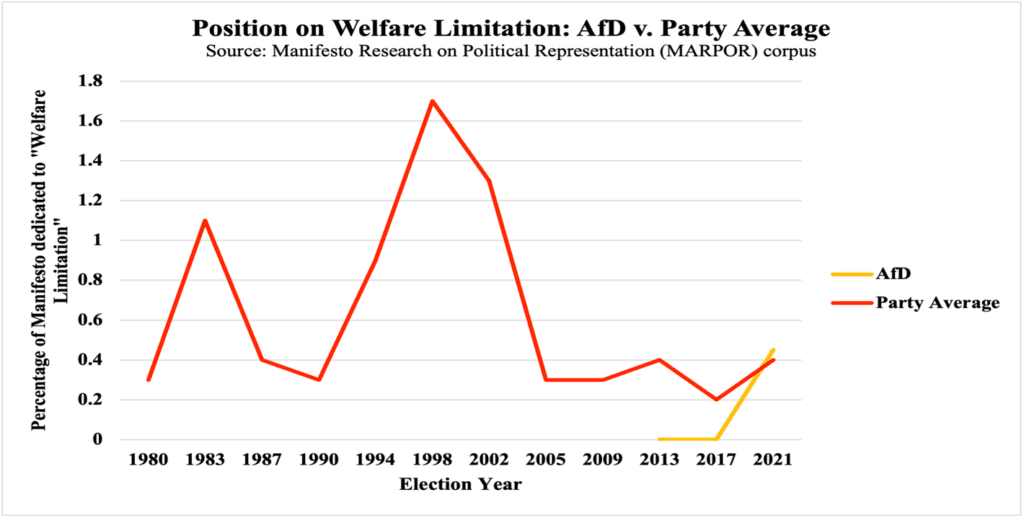
While the data visualized above is interesting, it needs to be analyzed within a conceptual framework and further contextualized if it is to have utility. I contextualize the data by briefly discussing the parties themselves, before analyzing more thoroughly what we can make of these findings.
Analysis
How can we explain these choices on the part of the RN and the AfD, and their convergences and divergences? Firstly, we can acknowledge that these trends do not fit the traditional models or theories of the European far right. We can, for instance, admit that Kitschelt’s “winning formula,” committing to free markets and ethnonationalism, has less explanatory power today than two decades ago when it was written. Even Kitschelt’s tepid 2004 mea culpa – which acknowledged that the far right adopted so-called “intermediate” economic positions and “attempted to tone down their market liberal rhetoric”[33] – is unsatisfactory in the face of the data I have presented above. De Lange put Kitschelt’s new theory to the test in 2007 and found that the RN, for instance, had in fact adopted a “centrist economic position.”[34] By 2017, even these observations seemed to undersell the transformation the RN had undertaken. As the data above indicates, the RN had become vaguely “centrist” in its position on welfare expansion (converging with the party average) by the 2017 election but had not adopted the centrist position on welfare limitation, axing any notion of it from its manifesto. This hints at a possibility not much explored by the literature: that we may be witnessing a fourth wave of far-right politics characterized by a strong move towards a “left,” not “centrist,” position on the welfare state.
While MARPOR data does not yet exist for the 2022 French elections, a supplemental analysis confirms the trend I outline above. As Le Monde put it in advance of this year’s presidential election, the 2022 election was in some ways a referendum on “the radically opposed manifestos of Le Pen and Macron.”[35] Some of the most potent tension between Macron, centrist extraordinaire, and the far-right Le Pen was on economic issues, and she placed herself firmly to his left on several issues. Le Pen pledged to institute new taxes on financial wealth, lower the value-added tax on energy (a tax that disproportionately affects the working class), renationalize France’s highways, and commit to a retirement age of sixty.[36] Meanwhile, Macron committed to increasing some welfare spending while making other programs conditional on ‘effective activity,’ i.e., employment, as well as making unemployment benefits less generous, all while raising the retirement age to somewhere between 62 and 65.[37]
This suggests that the trends observed in the data are not explainable using the position blurring thesis; Le Pen made economic issues the centerpiece of her campaign in 2022, rather than a coded, secondary, dynamic. Some observed that while her “past presidential campaigns have centred on pugnacious anti-immigration, eurosceptic rhetoric,” the 2022 campaign centered “a new message for voters…I’ll put money back in your pocket.”[38] Put another way, the RN “positioned itself primarily in economic territory,” centering “protectionist and interventionist policies,” an opposition to globalization, and the need to tackle the cost-of-living crisis.[39]
In the German case, these trends are less stark in the data and the supplemental analysis. Still, we can disregard the position blurring thesis outright. From 2013, the AfD prioritized economic issues, as can be seen in the makeup of its “scientific advisory board,” which boasted five economists in 2014, and whose “homogeneity is noteworthy since it accentuates the economic focus” of the party.[40] The party’s economic focus was most notably centered on rejecting the common European currency, the Euro, but had other dimensions as well.[41] All said, the early manifestos of the party contained “lengthy references to economic theory” and were “largely written in a rather technical and stilted language.”[42] This is not indicative of a party trying to blur its positions to garner support.
If its positions are not blurry, what does the AfD believe regarding the welfare state? From its founding, its economic ideology was murky. The party was largely considered neoliberal or, if you will, a “soft-eurosceptic, market-liberal and socially conservative outfit.”[43] Still, in its early years the party took positions that register more left than one may expect from a neoliberal party. For instance, circa 2013-2014 the AfD was arguing that “the ongoing financial crisis was to a large degree caused by irresponsible behaviour of the banks, which should be regulated more tightly.”[44] In 2015, the party’s profile transformed. Most of the literature focuses on the sociocultural dimensions of this transformation, noting that the party ceased being a single-issue party built on soft-euroscepticism and instead “developed a clear focus on common populist radical right topics: migration, Europe, and Islam.”[45]
This is true, but the transformation had economic dimensions as well. This can be seen in the data presented above; the AfD committed more attention to welfare expansion in every general election from 2013 to 2021. Elsewhere, scholars have noted “a slight move to the left” on the part of the AfD. One divergence from the French case lies in the question of welfare limitation. While the RN committed both to greater welfare expansion and less welfare limitation, the AfD have only embraced the former, and committed more manifesto space to welfare limitation in 2021 than in 2017. What explains this seeming contradiction in the German case? One explanation lies in the concept of so-called “welfare chauvinism” – the idea that welfare benefits “should be restricted to citizens, or natives only.”[46]
If a party is welfare chauvinist, it follows that their manifesto would reflect a desire to simultaneously expand and limit the welfare state, though the expansion would be limited to an in-group while the welfare limitation would be forced only onto an out-group. This is a viable explanation. Marx and Naumann have shown that welfare chauvinism became more salient among both the German electorate and within German parties (partially in response to voters’ demands) after the 2015 Syrian refugee crisis.[47]
A different, but equally viable explanation, lies in the so-called social investment v. welfare recalibration thesis. This typology is built upon a distinction between the absolute size of the welfare state and the type of policies it prioritizes. Put another way, it is built upon an argument over whether the welfare state should “invest in human skills or substitute income.”[48] Some parties prefer a welfare state that prioritizes consumption policies, while others envision the welfare state as a vehicle for investment. The far right falls squarely within the former.[49] Therefore, the AfD’s simultaneous emphasis on welfare expansion and limitation can possibly be explained as a preference for extending some elements of the welfare state (those of a consumptive profile) while limiting others (those of an investment profile). Whatever the explanations, we can firmly assert that the AfD does not subscribe to the “winning formula” of neoliberalism plus authoritarianism. Rather, since its conception, but increasingly since 2015, the party has embraced a “leftist” economic message that embraces a growing welfare state, at least in some dimensions.
Generalizing these trends
While it is outside the scope of this paper to offer a robust analysis of each case, it is important to ask whether the cautious trends observed above can be generalized to other far-right parties.
One might look to another German far-right party – the Nationaldemokratische Partei Deutschlands (NPD) – which has taken even more radical economic positions than the AfD. In fact, the NPD’s socioeconomic positions overlap considerably with the far-left Die Linke party (the only issue area where they did so), leading some to ask whether the parties are “ideological bedfellows.”[50] The NPD’s sloganeering in some ways supports this claim. The party’s program notes with dismay that “bit by bit the welfare state is being eroded,” and, in more radical language, asserts that “the focus of national politics is not…the profit interests of multinational corporations” and that “capital has to serve the economy and the economy has to serve the people.”[51] Sommer has illustrated the NPD’s evolution on socioeconomic questions, noting that by 1996-1997, the party’s ideological profile had moved “from anti-communism to anti-capitalism.”[52]
In practical terms, the party’s ideological agenda began prioritizing for the first time “unemployment, the economic problems of the welfare state and the so-called ‘social question,’” coming to a head in 1997 (it should be noted, this is the same year of the RN’s hard turn towards welfare expansionism) when four of the fifteen issues addressed in the party’s manifesto dealt with “the economic situation and contain[ed] harsh criticism of international capitalism and globalization.”[53] The party matched its actions to its program, designating May Day – international worker’s day – as an annual day for NPD demonstrations and participating, from the beginning, alongside unions and leftist groups in huge protests against a suite of reforms in 2004 that flexibilized the labor market and weakened the welfare state.[54]
Another far-right party in Germany, Die Republikaner (REP), is also indicative of this transformation, though to a much lesser degree than the NPD or later, the AfD. For the first decade or so after the party’s founding in 1983 it advocated for a so-called “social market economy,” one in which the state protects certain groups like families and pensioners, but also one in which “making several budget cuts [and] limiting the size and thereby the costs of the bureaucracy and state subsidies” is embraced and promoted.[55] By the 1990s, the party “started to address the interests of the lower classes more and more,” but did so in a schizophrenic way and the party’s position became “an amalgam of socialist policies and pleas for budget cuts and state subsidies, presented in a neo-liberal style.”[56] This amalgam was rationalized through the logic of welfare chauvinism: generous policies for German workers and neoliberal austerity for “immigrants, the EU and most notably asylum seekers.”[57] Today, that legacy continues. The REP’s website boasts support for various kinds of state intervention into the economy, from protecting small businesses from large corporations to protectionism against foreign countries, while simultaneously promoting a neoliberal, trickle-down economics story about cutting taxes and regulations to spur growth for the middle class.[58] Thus, the trend towards pro-welfarism is evident in the case of REP, if we compare its modern profile to that of its founding, but only barely so. It is far less evident than in the case of the NPD or the AfD.
In France, the main far-right competitor to the RN is Reconquête! (R!), founded in 2021 by the far-right provocateur Eric Zemmour. While it is obviously impossible to analyze the party’s evolution on welfare issues, given its recent founding and the fact that it has only contested one general election, its positions are instructive for gauging the broader political environment in France. Contra the RN, Zemmour’s partyhas maintained an economic profile that more closely adheres to the traditional far-right “winning formula” of neoliberal economics plus ethnonationalism. While Zemmour tends to emphasize the ethnonationalist piece of the equation – by prioritizing “security, immigration, and nativism”[59] – he also promotes a run-of-the-mill form of neoliberal economics. Zemmour’s neoliberalism is in part tactics, a part of the so-called l’Union des droites (Union of the Rights) strategy that seeks to reconcile the mainstream Right with the far right.[60] To do this, Zemmour has embraced the neoliberal economics that appeal to many of the voters of mainstream Right parties like Les Républicains (LR). But his economic views are also ideological, and he “defends neoliberalism in the sense of austerity measures and reducing government regulation, celebrates the business elites, and calls for halting redistributive measures.”[61] Thus, despite being newer than the RN, Reconquête! embodies an older kind of far-right politics, one which fits the mold of Kitschelt’s “winning formula.”
I raise these cases only to suggest that the trends I have identified are perhaps generalizable, rather than parochial. Rather than being the product of idiosyncratic factors within, say, the AfD, we can point to an economic leftward shift among multiple far-right parties in Germany and within the most prominent far-right party in France. That does not mean that every far-right party in Western Europe is now pro-welfare, the case of R! in France and REP in Germany are useful counterpoints to that assertion, merely that pro-welfarism is becoming an important characteristic of a certain, growing, subset of far-right parties.
If these findings are in fact indicative of a trend, or at least indicative of a trend within a noticeable subset of far-right parties, then it is important to briefly make a note of possible macro-explanations for the emergence of a pro-welfare far right. Why is it that we can observe these trends across time and space? One explanation emphasizes the vacuum left by social-democratic parties that moved sharply to the center after the struggles of the 1970s. This shift has been empirically shown in works like Dalton’s Citizen Politics: Public Opinion and Political Parties in Advanced Industrial Democracies and is partially implicated in the rise of the far right.[62]
As Berman and Snegovaya recount, social-democratic parties’ embrace of neoliberalism in the 1980s and 1990s “represented a transformation of the left’s longstanding profile, even its identity.”[63] Having abandoned its distinct identity, “the traditional left was poorly positioned to capture the resentment and anger that materialized when the weakening of the postwar social-democratic order produced its inevitable fallout: dramatic economic inequality and insecurity, as well as immense social disruption.”[64] Something was set to fill this vacuum; it turned out to be “a golden opportunity…for an enterprising political force…[right-wing] populism.”[65] This is a plausible explanation for the findings presented above, especially in its delayed timeline. Throughout the period of social-democratic parties’ neoliberalization, far-right parties like the RN retained their neoliberal character. It was only at the end of this process, in the early 2000s and especially after the financial crisis of 2007-2008 that far-right parties began to shift their economic profile leftwards. In other words, far-right parties did not move left as soon as their social-democratic counterparts began moving to the center. Rather, the process took some fifteen to twenty years to complete.
This delay can partially be attributed to so-called “issue salience.” Different than voters’ or parties’ political preferences, salience refers to the degree of intensity with which those groups believe in their preferences. As Berman puts it “individuals have many political preferences, but only those which are salient decisively influence political behavior. Many factors can shape salience, including external shocks like terrorist attacks or a wave of refugees, or intense media attention.”[66] In this case, the external shocks that increased the salience of welfare state expansion among far-right voters and parties was the dual crises of the financial crash of 2007-2008, and the Eurozone debt crisis that followed. In 2020-2022 period, the COVID-19 pandemic and Russia’s invasion of Ukraine – and the so-called “cost of living crisis” they produced – provided yet more external shocks that pushed the far right towards traditionally left-wing positions on the welfare state.
It can thus be said with some degree of confidence that it is unlikely that there is a singular, causal, explanation for why some far-right parties have moved left on issues related to the welfare state. What is important for our purposes is only that they observably have done so. Acknowledging this fact alone, and setting aside old theories about the far right’s positions vis-à-vis the welfare state, is an important first step in understanding the modern far right.
Conclusion
The idea of a fourth wave of far-right politics has not gained much steam in the literature. Mudde has increasingly used the term, both in his 2019 book The Far Right Today,[67] and in various other outlets,[68] but his conception of what characterizes a fourth wave excludes a deep analysis of far-right economic positions. For Mudde, the fourth wave is mostly characterized by the far right’s mainstreaming and normalization, i.e., the mainstream’s acceptance of the far right as a partner and legitimate political actor, and less by a shift in ideological profile.
While Mudde is correct in this respect, the evidence I have presented above suggests an ideological transformation is occurring concurrently. If the trends presented above can be generalized beyond the RN and the AfD, then perhaps it is time to start discussing a fourth wave of far-right politics that centers not just far-right parties moving left on economic issues, but also far-right parties’ increased prioritization of economic issues. No longer a marginal part of their appeal, traditionally left-wing positions on the welfare state and redistribution are more and more becoming integral parts of the far-right project in Europe. This leftward shift on economics is not hegemonic among far-right parties, but it can be said to characterize an important subset of parties within the European far right.
Far from being an exception that proves the rule that neoliberal economics is integral to the European far-right project, this leftward shift on economic issues within the RN and the AfD is indicative of a sea change in the profile of a growing number of far-right parties. Time will tell if these trends continue, but it is worth analyzing them soberly and seriously.
[1] Leila Abboud and Tommy Stubbington, “Marine Le Pen Exploits Cost of Living Fears as French Run-off Vote Looms,” Subscribe to read | Financial Times (Financial Times, April 15, 2022), https://www.ft.com/content/c606a189-4fe6-4c50-b7e5-5ed743c50a70.
[2] Tom Rees, “Marine Le Pen’s Populist Policies Threaten to Trash the French Economy,” The Telegraph (Telegraph Media Group, April 14, 2022), https://www.telegraph.co.uk/business/2022/04/14/marine-le-pens-populist-policies-threaten-trash-french-economy/.
[3] Angelique Chrisafis, “Voters in Northern France Wooed by Marine Le Pen’s Cost of Living Policies,” The Guardian (Guardian News and Media, April 20, 2022), https://www.theguardian.com/world/2022/apr/20/voters-in-northern-france-wooed-by-marine-le-pens-cost-of-living-policies.
[4] Andrea L Pirro, “Far Right: The Significance of an Umbrella Concept,” Nations and Nationalism, 2022, https://doi.org/10.1111/nana.12860, 3.
[5] Ibid., 4
[6] Ibid., 4
[7] Ibid., 4
[8] Cas Mudde, “The Extreme Right Party Family,” in The Ideology of the Extreme Right (Manchester, UK: Manchester University Press, 2000), pp. 1-30, 10.
[9] Ibid., 10
[10] Pietro Castelli Gattinara and Andrea L. Pirro, “The Far Right as Social Movement,” European Societies 21, no. 4 (2018): pp. 447-462, https://doi.org/10.1080/14616696.2018.1494301, 450.
[11] Cas Mudde, “The War of Words Defining the Extreme Right Party Family,” West European Politics 19, no. 2 (1996): pp. 225-248, https://doi.org/10.1080/01402389608425132.
[12] Cas Mudde, Populist Radical Right Parties in Europe (Cambridge, UK: Cambridge University Press, 2009), 11-12.
[13] Pirro, 3.
[14] Steven Levitsky, The Resurgence of the Latin American Left (Baltimore, MD: Johns Hopkins Univ. Press, 2011), 5-6.
[15] Ibid., 22-23
[16] S. Erdem Aytaç and Ziya Öniş, “Varieties of Populism in a Changing Global Context: The Divergent Paths of Erdoğan and Kirchnerismo,” Comparative Politics 47, no. 1 (January 2014): pp. 41-59, https://doi.org/10.5129/001041514813623137, 45.
[17] Mudde, Populist Radical Right Parties in Europe, 119.
[18] Hans-Georg Betz, “The Two Faces of Radical Right-Wing Populism in Western Europe,” The Review of Politics 55, no. 4 (1993): pp. 663-686, https://doi.org/10.1017/s0034670500018040., 679
[19] Herbert Kitschelt and Anthony J. McGann, The Radical Right in Western Europe a Comparative Analysis (Ann Arbor, MI: The University of Michigan Press, 1997).
[20] Piero Ignazi, Extreme Right Parties in Western Europe (Oxford, UK: Oxford University Press, 2003).
[21] Matt Golder, “Far Right Parties in Europe,” Annual Review of Political Science 19, no. 1 (November 2016): pp. 477-497, https://doi.org/10.1146/annurev-polisci-042814-012441, 490.
[22] Jan Rovny, “Where Do Radical Right Parties Stand? Position Blurring in Multidimensional Competition,” European Political Science Review 5, no. 1 (2012): pp. 1-26, https://doi.org/10.1017/s1755773911000282, 3.
[23] Bent Greve, Welfare, Populism and Welfare Chauvinism (Bristol, UK: Policy Press, 2019).
[24] Rovny, 1
[25] Matthias Enggist and Michael Pinggera, “Radical Right Parties and Their Welfare State Stances – Not so Blurry after All?,” West European Politics 45, no. 1 (January 2021): pp. 102-128, https://doi.org/10.1080/01402382.2021.1902115.
[26] Ibid., 107
[27] Jens Rydgren, “Is Extreme Right-Wing Populism Contagious? Explaining the Emergence of a New Party Family,” European Journal of Political Research 44, no. 3 (2005): pp. 413-437, https://doi.org/10.1111/j.1475-6765.2005.00233.x, 415.
[28] Ibid., 415.
[29] Ibid., 416
[30] Manifesto Project Team, “Working with the Manifesto Project Dataset (Main Dataset),” Manifesto Project Database, 2018, https://manifesto-project.wzb.eu/tutorials/main-dataset.
[31] Alexander Horn et al., “Peeping at the Corpus – What Is Really Going on behind the Equality and Welfare Items of the Manifesto Project?,” Journal of European Social Policy 27, no. 5 (2017): pp. 403-416, https://doi.org/10.1177/0958928716688263, 412.
[32] Ibid., 412-413
[33] Herbert Kitschelt, “Diversification and Reconfiguration of Party Systems in Postindustrial Democracies,” Friedrich Ebert-Stiftung Foundation, 2004, https://library.fes.de/pdf-files/id/02608.pdf, 8-10.
[34] Sarah L. de Lange, “A New Winning Formula? The Programmatic Appeal of the Radical Right,” Party Politics 13, no. 4 (2007): pp. 411-435, https://doi.org/10.1177/1354068807075943, 422.
[35] Adrien Sénécat and William Audureau, “French Presidential Election 2022: The Radically Opposed Manifestos of Le Pen and Macron,” Le Monde.fr (Le Monde, April 11, 2022), https://www.lemonde.fr/en/politics/article/2022/04/12/le-pen-and-macron-two-diametrically-opposed-manifestos_5980313_5.html.
[36] Ibid.
[37] Ibid.
[38] Michel Rose and Elizabeth Pineau, “Analysis: Cost of Living Woes Boost ‘Phoenix’ Le Pen in Race for French Presidency,” Reuters (Thomson Reuters, March 30, 2022), https://www.reuters.com/world/europe/cost-living-woes-boost-phoenix-le-pen-race-french-presidency-2022-03-30/.
[39] Nicholas Startin, “Marine Le Pen, the Rassemblement National and Breaking the ‘Glass Ceiling’? the 2022 French Presidential and Parliamentary Elections,” Modern &Amp; Contemporary France 30, no. 4 (February 2022): pp. 427-443, https://doi.org/10.1080/09639489.2022.2138841, 433.
[40] Nicole Berbuir, Marcel Lewandowsky, and Jasmin Siri, “The AFD and Its Sympathisers: Finally a Right-Wing Populist Movement in Germany?,” German Politics 24, no. 2 (2014): pp. 154-178, https://doi.org/10.1080/09644008.2014.982546, 163.
[41] Ibid.
[42] Arzheimer, 546
[43] Kai Arzheimer and Carl C. Berning, “How the Alternative for Germany (AFD) and Their Voters Veered to the Radical Right, 2013–2017,” Electoral Studies 60 (2019): pp. 1-10, https://doi.org/10.1016/j.electstud.2019.04.004, 2.
[44] Kai Arzheimer, “The AFD: Finally a Successful Right-Wing Populist Eurosceptic Party for Germany?,” West European Politics 38, no. 3 (2015): pp. 535-556, https://doi.org/10.1080/01402382.2015.1004230, 546.
[45] Arzheimer and Berning, 3
[46] Alexandre Afonso and Line Rennwald, “Social Class and the Changing Welfare State Agenda of Radical Right Parties in Europe,” in Welfare Democracies and Party Politics: Explaining Electoral Dynamics in Times of Changing Welfare Capitalism, ed. Philip Manow, Bruno Palier, and Hanna Schwander (Oxford, UK: Oxford University Press, 2018), pp. 173-194, 178.
[47] Paul Marx and Elias Naumann, “Do Right-Wing Parties Foster Welfare Chauvinistic Attitudes? A Longitudinal Study of the 2015 ‘Refugee Crisis’ in Germany,” Electoral Studies 52 (2018): pp. 111-116, https://doi.org/10.1016/j.electstud.2018.01.011.
[48] Enggist and Pinggera, 119
[49] Ibid.
[50] Benjamin Rayder, Calculated Competitors or Ideological Bedfellows?: A Comparative Analysis of the Policy Similarities and Differences Between the National Democratic Party of Germany (NPD) and Die Linke in the Saxon State Parliament During the 5th Legislative Period, 2009-2014 (Bamberg, DE: Otto-Friedrich-Universität, 2017).
[51] “Our Program for Germany: Social,” NPD: The Party for Peace, Freedom, Sovereignty (retained via Internet archive: Wayback Machine), 2022, https://web.archive.org/web/20220314111404/https://npd.de/themen/soziales/.
[52] Bernd Sommer, “Anti-Capitalism in the Name of Ethno-Nationalism: Ideological Shifts on the German Extreme Right,” Patterns of Prejudice 42, no. 3 (2008): pp. 305-316, https://doi.org/10.1080/00313220802204046, 307.
[53] Ibid., 308
[54] Ibid., 308
[55] Cas Mudde, “ Die Republikaner,” in The Ideology of the Extreme Right (Manchester, UK: Manchester University Press, 2000), pp. 31-59, 49.
[56] Ibid., 50
[57] Ibid., 50
[58] “Finance and Taxes,” DIE REPUBLIKANER (REP) (retained via Internet Archive: Wayback Machine), 2022, https://web.archive.org/web/20221210032040/https://www.die-republikaner.net/unsere-standpunkte/finanzen-und-steuern/.
[59] Périne Schir and Marlène Laruelle, “Eric Zemmour, the New Face of the French Far Right: Media-Sponsored, Neoliberal, and Reactionary,” Journal of Illiberalism Studies 2, no. 2 (2022): pp. 1-17, https://doi.org/10.53483/wcks3540, 5.
[60] Masha P. Davis, “When the Far Right Courts the Right,” IERES Occasional Papers, 2020, https://www.historyofthefarright.org/when-the-far-right-courts-the-right-understanding-marion-marechals-project-of-a-union-of-the-rights-in-france/.
[61] Schir and Laruelle, 15
[62] Russell J. Dalton, Citizen Politics: Public Opinion and Political Parties in Advanced Industrial Democracies (Los Angeles, CA: CQ Press, 2020).
[63] Sheri Berman and Maria Snegovaya, “Populism and the Decline of Social Democracy,” Journal of Democracy 30, no. 3 (2019): pp. 5-19, https://doi.org/10.1353/jod.2019.0038, 9.
[64] Ibid., 9
[65] Ibid., 9
[66] Sheri Berman, “The Causes of Populism in the West,” Annual Review of Political Science 24, no. 1 (November 2021): pp. 71-88, https://doi.org/10.1146/annurev-polisci-041719-102503, 82.
[67] Cas Mudde, The Far Right Today (Cambridge, UK: Polity Press, 2019).
[68] See for example, Cas Mudde, “Riding the Fourth Wave,” IPPR Progressive Review 26, no. 4 (2020): pp. 296-304, https://doi.org/10.1111/newe.12175.


